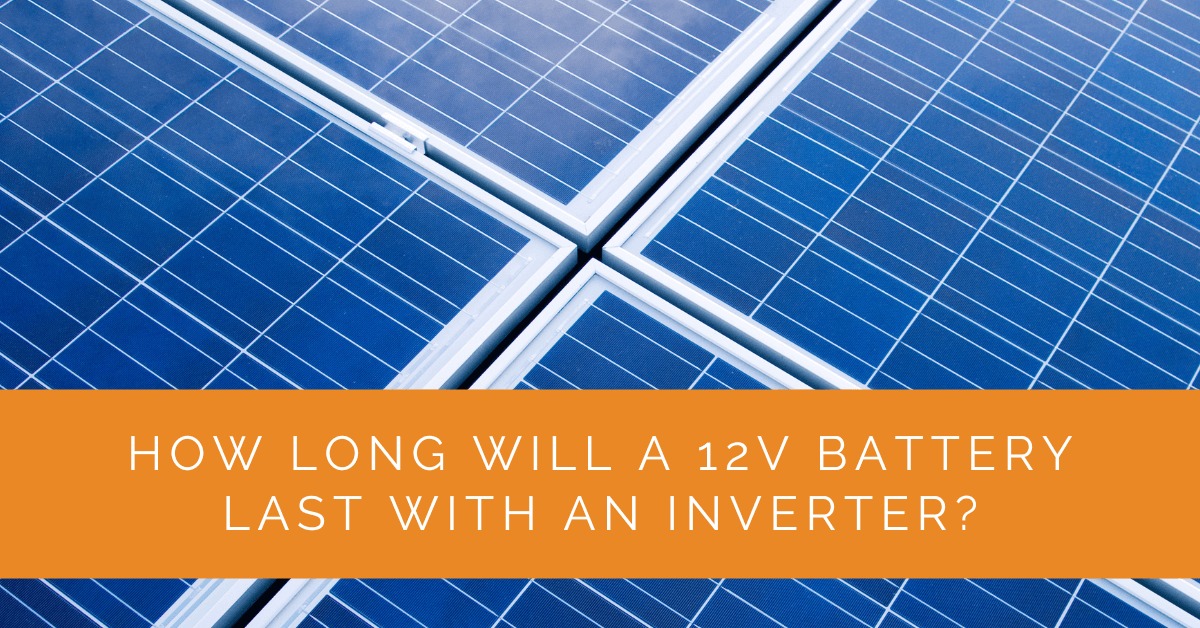In off-grid solar power systems, understanding the battery life when using an inverter is crucial for optimizing performance. Whether you’re powering appliances, devices, or tools, knowing how long your 12V battery will last with an inverter allows you to plan your power usage effectively. In this article, we will delve into the factors that impact battery run time, different types of inverters, and how to calculate the approximate run time of your 12V battery. Additionally, we will provide practical tips on extending battery life and optimizing your solar power system.
Contents
- 1 Key Takeaways
- 2 Understanding Battery Run Time
- 3 Different Inverter Types
- 4 Calculating Battery Run Time
- 5 Factors Affecting Battery Life
- 6 Tips for Extending Battery Life
- 7 Case Study: Optimizing Battery Life in an Off-Grid Solar Power System
- 8 Expert Insights From Our Solar Panel Installers About Battery Run Time with Inverters
- 9 Experience Solar Excellence with Us!
- 10 Conclusion
Key Takeaways
- Understanding battery run time with an inverter involves considering factors such as battery capacity, inverter efficiency, load requirements, and battery type.
- Pure sine wave inverters provide stable power for most devices, while modified sine wave inverters may cause compatibility issues with sensitive electronics.
- Calculating battery run time involves considering the battery capacity, power requirements of devices, inverter efficiency, and estimating the watt-hours required. Proper maintenance, temperature management, and efficient power usage practices can help extend battery life.
Understanding Battery Run Time
To accurately estimate how long a 12V battery will last with an inverter, it’s essential to understand the factors influencing battery run time. Factors such as battery capacity, power rating of the inverter, and load requirements all significantly determine how long the battery can power your devices. The following section will delve deeper into these factors and explore their impact on battery run time. Let’s explore the key factors affecting battery run time:
Factors Affecting Battery Run Time
To understand how long a 12V battery will last with an inverter, it’s important to consider the factors influencing battery run time. These factors include:
- Battery Capacity: The capacity of a battery is typically measured in ampere-hours (Ah) and indicates the amount of energy it can store. A higher-capacity battery can provide power for a longer duration before needing to be recharged.
- Power Rating of the Inverter: The inverter’s power rating, measured in watts (W), determines the maximum load it can handle. Selecting an inverter that matches the power requirements of the devices you intend to power is crucial.
- Efficiency of the Inverter: Inverters are not 100% efficient in converting DC power from the battery to AC power for devices. A certain amount of energy is lost during the conversion process. The efficiency of an inverter represents how effectively it utilizes the battery’s energy. Higher efficiency inverters can convert more of the battery’s power into usable AC power, maximizing battery run time.
- Load Requirements: The power consumption of the devices connected to the inverter affects battery run time. Different devices and appliances draw varying amounts of power. It’s important to consider the power requirements of the specific devices you plan to power to estimate the battery run time accurately.
Different Inverter Types
When it comes to inverters, there are two common types: pure sine wave and modified sine wave. Understanding the differences between these types is essential for selecting the right inverter for your battery and optimizing performance.
- Pure Sine Wave Inverters: A pure sine wave inverter produces a smooth and clean AC voltage waveform that closely resembles the power supplied by the grid. This type of inverter is suitable for powering various devices, including sensitive electronics, appliances, and tools. Pure sine wave inverters provide stable and reliable power, resulting in better device performance and longevity.
- Modified Sine Wave Inverters: In contrast, a modified sine wave inverter generates a stepped waveform that approximates a sine wave. While it can power many devices, it may cause compatibility issues with certain appliances, especially those with sensitive electronics. Devices such as motors, fluorescent lights, and audio equipment may experience reduced performance or produce more noise when operated with a modified sine wave inverter.
Choosing the appropriate inverter type depends on the devices you plan to power. A pure sine wave inverter is recommended to ensure optimal performance and avoid potential issues if you have sensitive electronics or appliances with specific power requirements.

Calculating Battery Run Time
To estimate the run time of a 12V battery with an inverter, you can follow these steps:
- Determine Battery Capacity: Identify the capacity of your battery, typically expressed in ampere-hours (Ah). For example, consider a 100Ah battery.
- Power Consumption Calculation: Determine the power consumption of the devices you intend to power with the inverter. Calculate the total wattage required by adding up the power ratings of the devices. For instance, if you plan to power 200W and 300W devices, the total power consumption would be 500W.
- Consider Inverter Efficiency: Consider your inverter’s efficiency, as it affects how much power it can effectively convert. Most inverters have an efficiency rating provided by the manufacturer, typically expressed as a percentage. Multiply the total power consumption by the inverter efficiency to obtain the effective power requirement.
- Calculate Watt-Hours: Multiply the effective power requirement (in watts) by the estimated run time (in hours) to obtain the total watt-hours required. For example, if your effective power requirement is 400W and you anticipate a run time of 4 hours, the total watt-hours required would be 1600Wh.
- Estimate Battery Run Time: Divide the battery capacity (in watt-hours) by the total watt-hours required to operate your devices. This calculation will give you an estimate of the run time. Using the previous example with a 100Ah battery and 1600Wh total watt-hours required, the estimated run time would be approximately 16 hours.
It’s important to note that these calculations provide an approximation, as various factors can impact actual battery run time. Environmental conditions, depth of discharge, battery age, and efficiency variations can influence the battery’s and the inverter’s performance.
By following these steps, you can estimate how long your 12V battery will last with a specific inverter and power load. This information lets you plan your energy usage more effectively and ensure sufficient power for your needs.
Factors Affecting Battery Life
Several factors can influence a battery’s overall lifespan and performance when used with an inverter. Understanding these factors and taking appropriate measures can help maximize the battery’s longevity. Here are some key considerations:
- Battery Type: The type of battery used in your system can significantly impact its performance and lifespan. Common battery types for solar applications include lead-acid batteries and lithium-ion batteries.
- Lead-Acid Batteries: These are widely used and come in different variants, such as flooded lead-acid (FLA) and sealed lead-acid (SLA) batteries. FLA batteries require periodic maintenance, including checking electrolyte levels and ensuring proper ventilation. SLA batteries, including absorbed glass mat (AGM) and gel batteries, are maintenance-free and offer improved safety and durability.
- Lithium-Ion Batteries: Lithium-ion batteries are known for their high energy density, longer lifespan, and lighter weight than lead-acid batteries. They require minimal maintenance and have a higher upfront cost. However, they provide excellent performance, deeper depth of discharge, and longer cycle life.
- Depth of Discharge (DoD): The depth to which a battery is discharged during each cycle can affect its lifespan. Lead-acid batteries, for example, can have a longer life expectancy when operated within a specific depth of discharge range. Deep-cycle batteries, designed for renewable energy applications, are specifically suited to handle deeper discharges without significantly harming their longevity.
- Battery Voltage: The battery’s voltage is important when selecting an inverter and calculating run time. It represents the potential energy stored in the battery. As the battery discharges, its voltage gradually decreases. It’s crucial to consider the voltage range within which your inverter operates efficiently to maximize both inverter and battery performance.
- Temperature: The battery’s operating temperature can affect its performance and lifespan. Extreme hot and cold temperatures can degrade battery efficiency and reduce overall life expectancy. Keep the battery in a temperature-controlled environment to ensure optimal performance whenever possible.
- Charging and Discharging Practices: Proper charging and discharging practices are essential for maintaining battery health. Avoid overcharging or deep discharging the battery, which can cause irreversible damage. Follow the manufacturer’s recommendations for charging profiles and consider using charge controllers or battery management systems to ensure safe and efficient charging.
By taking these factors into account and implementing appropriate measures, you can extend the life of your battery, optimize its performance, and maximize your investment in the solar power system.

Tips for Extending Battery Life
To extend the life of your battery when using an inverter, consider the following tips:
- Proper Charging: Follow the manufacturer’s guidelines for charging your battery. Ensure that you use a suitable charger compatible with your battery type. Avoid overcharging or undercharging the battery, as both can negatively impact its performance and lifespan. Implement a charging regimen matching your specific battery’s recommended voltage and current levels.
- Temperature Management: Extreme temperatures can have a significant impact on battery life. Whenever possible, keep the battery in a temperature-controlled environment. High temperatures can accelerate battery degradation, while very low temperatures can reduce the battery’s capacity. Consider insulating the battery or using thermal management techniques to maintain optimal operating temperatures.
- Regular Maintenance: Perform regular maintenance checks on your battery. Inspect the battery for any signs of damage, corrosion, or leakage. Clean the terminals and connections, ensuring they are tight and debris-free. Regularly check the electrolyte levels for flooded lead-acid batteries and maintain them within the recommended range. Follow the manufacturer’s maintenance guidelines to keep your battery in optimal condition.
- Avoid Deep Discharges: Deeply discharging a battery can shorten its lifespan. If possible, avoid discharging the battery below a certain depth of discharge (DoD) recommended by the battery manufacturer. For example, keeping the DoD between 20% and 50% can help prolong the battery’s life. Consider using a battery monitor or management system to track the state of charge and prevent deep discharges.
- Optimize Power Usage: Efficient power management can help extend battery life. Be mindful of the power requirements of your devices and appliances connected to the inverter. Use energy-efficient devices and consider implementing energy-saving practices such as turning off unused devices and appliances. Distribute the load evenly across the battery to prevent overloading and excessive strain on the system.
- Proper Storage: If the battery will be unused for an extended period, store it in a charged state. Consult the manufacturer’s guidelines for specific storage recommendations. Keep the battery in a cool and dry environment to minimize self-discharge and preserve its capacity. Periodically check the battery’s charge level during storage and recharge to maintain optimal performance.
- Consider Battery Cycling: Periodically cycling the battery can help maintain its capacity and improve overall performance. This involves discharging the battery to a certain DoD and fully recharging it. Consult the battery manufacturer’s recommendations for the appropriate cycling frequency and DoD range.
By following these tips, you can prolong the life of your battery, maximize its capacity and performance, and ensure a reliable power supply from your inverter. Proper maintenance, temperature management, and efficient power usage are key to extending battery life and optimizing your solar power system.
Remember to refer to the specific guidelines provided by your battery and inverter manufacturers for best practices and recommendations tailored to your system.
Case Study: Optimizing Battery Life in an Off-Grid Solar Power System
Background
At Solar Panels Network USA, we frequently assist clients in setting up and maintaining off-grid solar power systems. This case study examines a client project focused on maximizing the lifespan and efficiency of a 12V battery used with an inverter. The client’s objective was to power essential household appliances and devices sustainably.
Project Overview
Client: Off-grid living enthusiasts.
Location: Rural Arizona, USA.
System Components:
- 12V, 200Ah deep-cycle lead-acid battery.
- 1000W pure sine wave inverter.
- Solar panel array totaling 800W.
- Charge controller and battery monitoring system.
Implementation
- Step 1: System Design and Equipment Selection: The first step was designing a system tailored to the client’s energy needs. Given the rural location, we chose a high-capacity deep-cycle battery for its ability to handle prolonged discharges and recharges. A pure sine wave inverter was selected to ensure clean power suitable for sensitive electronics.
- Step 2: Installation and Setup: Our team installed the solar panels to maximize sunlight exposure, considering the local climate and shading factors. The charge controller was set up to regulate the charging process, protecting the battery from overcharging and deep discharges.
Battery Run Time Calculation
To help the Greens understand how long their 12V battery would last, we conducted the following calculations:
Battery Capacity
200Ah battery at 12V = 2400Wh (Watt-hours).
Load Requirements
- Refrigerator: 100W, running 24 hours a day = 2400Wh.
- LED Lighting: 50W, running 5 hours a day = 250Wh.
- Laptop: 60W, running 4 hours a day = 240Wh.
- Total Daily Load = 2400 + 250 + 240 = 2890Wh.
Inverter Efficiency
Assumed 90% efficiency for the pure sine wave inverter.
Effective power requirement: 2890Wh / 0.9 = 3211Wh.
Estimated Battery Run Time
2400Wh battery capacity / 3211Wh daily load = approximately 0.75 days (18 hours) of continuous use without recharging.
Results
Performance Monitoring
The system was monitored using a battery management system to track the state of charge and energy usage patterns. The data helped in adjusting the energy consumption and optimizing solar panel angles for better performance.
Maintenance Practices
- Regular cleaning of solar panels to ensure maximum efficiency.
- Monthly checks of battery electrolyte levels and terminal connections.
- Maintaining a temperature-controlled environment for the battery to prevent performance degradation.
Outcomes
- Increased Battery Life: By implementing proper charging cycles, avoiding deep discharges, and maintaining optimal temperatures, the Greens reported extended battery life and reliable power supply.
- Enhanced System Efficiency: The use of a pure sine wave inverter and regular maintenance practices resulted in improved system efficiency, reducing the need for frequent battery replacements.
Summary
This case study highlights the importance of understanding battery run time with an inverter in off-grid solar power systems. By considering factors such as battery capacity, inverter efficiency, and load requirements, and implementing proper maintenance practices, users can optimize their solar power systems for reliable and sustainable energy supply.
Expert Insights From Our Solar Panel Installers About Battery Run Time with Inverters
Understanding battery capacity and how it interacts with your inverter is crucial for maximizing efficiency and ensuring you have power when you need it. It’s important to remember that the efficiency of your system depends on the quality of the components and the environmental conditions they are subjected to.
Renewable Energy Specialist
Selecting the right inverter and battery combination is key. Pure sine wave inverters, although slightly more expensive, provide cleaner power that is better for sensitive electronics, which can ultimately lead to better performance and longer-lasting equipment.
Solar Power Engineer
Proper maintenance and regular monitoring of your solar power system can significantly extend the life of your battery. Simple practices like avoiding deep discharges and maintaining optimal temperatures make a big difference.
Solar System Technician
Experience Solar Excellence with Us!
Trust in Solar Panels Network USA, where our seasoned experts deliver top-quality solar solutions for homes and businesses nationwide. With a legacy of countless successful installations and a commitment to sustainable energy, we’re your reliable partner in the solar journey. Ready for a brighter, eco-friendly future? Call us now at (855) 427-0058 and harness the power of the sun!
Conclusion
Understanding how long a 12V battery will last with an inverter is essential for effectively utilizing solar power systems. You can estimate the approximate run time and optimize your power usage by considering factors such as battery capacity, inverter efficiency, load requirements, and battery type. Remember to follow proper maintenance practices and implement energy-saving measures to maximize the battery’s lifespan. Doing so lets you enjoy an uninterrupted power supply and make the most of your solar power system.
About the Author
Solar Panels Network USA stands at the forefront of solar energy solutions, driven by a team of seasoned solar engineers and energy consultants. With over decades of experience in delivering high-quality solar installations and maintenance, we are committed to promoting sustainable energy through customer-centric, tailored solutions. Our articles reflect this commitment, crafted collaboratively by experts to provide accurate, up-to-date insights into solar technology, ensuring our readers are well-informed and empowered in their solar energy decisions.

